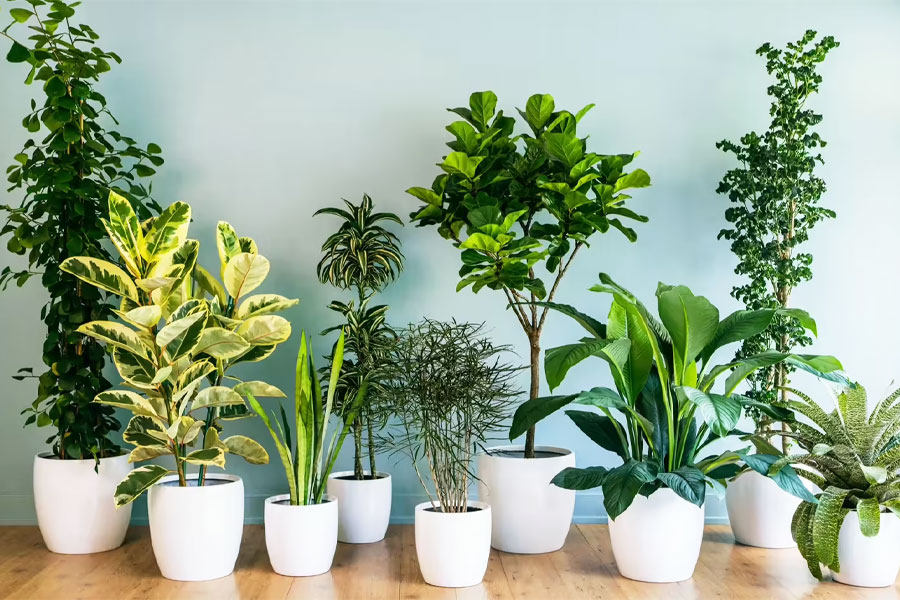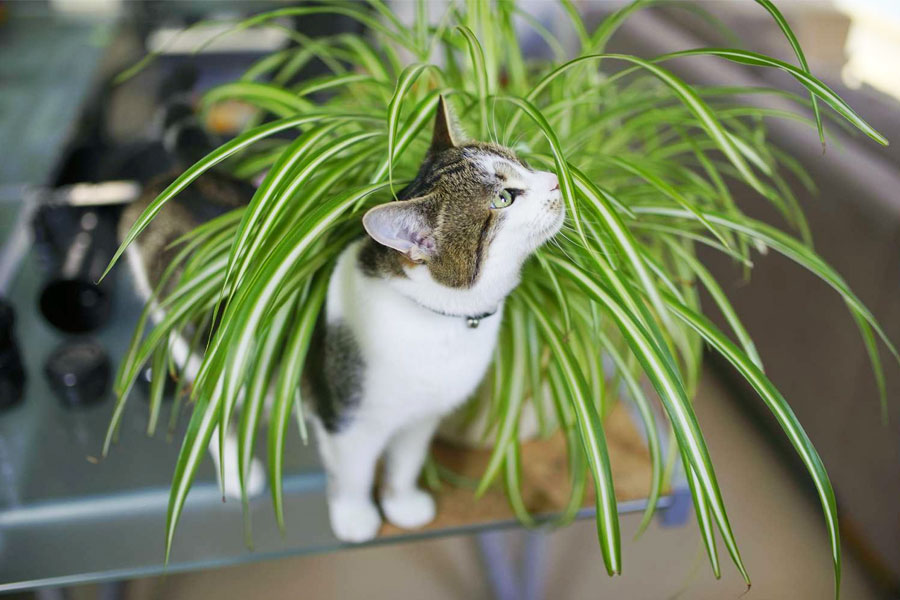
We have two intense loves in our lives: plants and dogs. So we’re searching for pet-friendly plants that won’t harm your furry friends if they nibble. For the uninitiated, many plants can be poisonous to pets when consumed, resulting in seizures, tremors, or worse.
Even the most well-behaved animals may sometimes eat a houseplant, so we asked New Jersey veterinarian Judy Morgan for tips on choosing ones that won’t injure our four-legged companions. Here are 20 lovely, non-toxic plants that are safe for cats.
Top 20 Cat-Friendly Plants
1. Boston Fern (Nephrolepis)

Boston fern is a typical decorative plant often grown as a houseplant in chilly climes. Nephrolepis exaltata is a tropical sword fern (of the Lomariopsidaceae family) found in humid woods from northern South America to Mexico, Florida, and the West Indies, where it may reach 7 feet.
It also adapts well to container culture for use inside or seasonally outside in other regions of the world. The plant is safe for your pets, so you may use these luscious plants to liven up your guest room or bathroom.
2. Banana Tree (Musa Spp.)

The Musa genus has around 80 flowering plant species, including the edible banana. Bananas are usually called trees, yet they do not have a wooden stem. Bananas are big herbaceous plants with thick, erect stalks that produce massive, rectangular, brilliant green leaves.
Showy blooms often bloom in the spring, giving place to meaty, elongated, green, or yellow fruits. A central stem divides into long, broad leaves occasionally employed in tropical cuisine to steam or serve meals. Unsurprisingly, the ASPCA declared this plant non-toxic, making it a safe houseplant for cats.
3. Chinese Money Plant (Pilea Peperomioides)

The Chinese Money Plant, or Pilea Peperomioides, is a well-liked houseplant with rounded, coin-shaped leaves that stand for wealth and fortune. This low-maintenance plant is native to China and is famous for its distinctive appearance and uncomplicated care requirements.
Its tiny size and eye-catching foliage make it an ideal home or workplace design accent. This plant is not only visually appealing, but it also has air-purifying properties, making it an excellent choice for interior environments. The Pilea Peperomioides brings a splash of green and wealth to your surroundings. This plant is suitable for families with cats and dogs.
4. Baby’s Tears (Soleirolia Soleirolii)

Baby’s Tears (Soleirolia soleirolii) is a mat-forming tropical perennial with many little leaves. It is sometimes mistaken for moss but is a member of the nettle family. What distinguishes baby tears is a thick, delicate mat of fine, round, or bean-shaped leaves on short, fleshy stalks.
This plant thrives in low-light environments, warmer climates, and rich, wet soil. Baby’s tears plants are simple to maintain for novices but require regular maintenance to look their best. Baby tears plants cover the dirt, which may stop pets from digging in your common houseplants.
5. African Violet (Saintpaulia)

African violets are little houseplants that thrive at typical indoor temperatures. They continually flower in clusters of white, blue, or purple flowers over fuzzy leaves. Despite their widespread name, African violets are not a kind of violet but produce vibrant violet-colored blooms.
African violets are currently classified within the genus Streptocarpus. However, as the name implies, they are native to East Africa, specifically the tropical rainforests of Tanzania and Kenya. African violets (Saintpaulia) are among the most popular blooming safe pet houseplants.
6. Echeveria (Echeveria Spp.)

Echeverias are fast-growing succulents known for their distinctive look and low care requirements. Their gorgeous rosette form, plump leaves, and wide range of colors make them very similar to flowers. In the summer, they bloom beautifully.
Plant them in the spring, at the beginning of their growing season. Most echeveria stay tiny, little more than a foot wide, but other species grow as small shrub-like plants up to two feet tall. This stunning succulent is non-toxic and suitable for cats and dogs.
7. Venus Fly Trap (Dionaea Muscipula)

The Venus flytrap is a ferocious, flesh-eating plant with serrated leaves resembling snapping jaws that trap and consume insects and spiders. They dwell in nutrient-poor soils and rely on elaborate traps for food. When an insect falls and comes into contact with tiny trigger hairs on the inner surface of a Venus flytrap’s leaves, they snap close, and the interlocking teeth seal the trap.
The leaves then shut tighter, squashing the prey, which is subsequently digested by enzymes to produce a nourishing soup. Venus fly traps (Dionaea muscipula) are non-toxic to cats and dogs, so a curious nibble will not require a trip to the doctor.
8. Gloxinia (Sinningia Speciosa)

Gloxinia hybrids are compact, blooming houseplants that grow to six to ten inches in height. They are low-light plants and should be maintained away from harsh, direct sunlight. They require frequent watering, and the soil should be kept wet during the growth season.
Gloxinia is a beautiful flowering houseplant suitable for dogs and cats. Its thick, ruffled leaves and single or double flowers (white, red, pink, lavender, purple, or blue) are safe for cats.
9. Areca Palm (Dypsis Lutescens)

Areca palms are tall, beautiful, clumping palms with smooth, golden trunks that resemble bamboo clusters. Their fronds are slender and full, like bamboo leaves. In the summer, little, bright yellow blooms emerge between the leaves.
It’s also a popular houseplant. When cultivated inside, these palms seldom flower. Palm fronds can occasionally arouse a cat’s playful swatting and biting impulses, so it’s reassuring to know that the areca palm isn’t harmful to your furry friend.
10. Haworthia (Haworthia Spp.)

Haworthia, often known as zebra cactus, pearl, star window, or cushion aloe, is a vast genus of tiny, slow-growing succulent plants. It resembles little aloe plants, with mushy green leaves coated with white pearly warts or bands. Haworthia is commonly kept inside and prefers temperatures ranging from 70 to 95 degrees Fahrenheit.
Haworthia flourishes in sandy, well-drained, neutral soil with ample summer rainfall and dry winter conditions. Unlike similar-looking aloe plants, the Haworthia genus is safe for cats and dogs.
11. Calathea (Calathea Spp.)

Some of the world’s most attractive tropical plants belong to the genus Calathea. They are distinguished by aggressively defined, oblong leaves in a brilliant palette of colors. The plants’ eye-catching stripes and veining have earned them titles such as zebra, peacock, and rattlesnake.
These plants are ideal for a shaded position in a pet-friendly home because too much light can diminish the leaf’s color.
12. Polka Dot Plant (Hypoestes Phyllostachya)

Polka dot plant (Hypoestes phyllostachya), often known as freckle face plant, is a herbaceous warm-climate perennial with brilliantly variegated leaves. The most popular polka dot plants have green leaves with pink flecks, but there are also purple, white, and red variegated variations.
Polka dot plants thrive in warm, humid environments with bright, indirect light or moderate shade. Although not hazardous to cats and dogs, sensitive pets may develop moderate stomach discomfort if they ingest excessive amounts of the polka dot.
13. Prayer Plant (Maranta Leuconeura)

The Prayer Plant, scientifically known as Maranta leuconeura, is an excellent addition to your home. It enthralls novices and professionals with its vibrant leaf colors and notable nocturnal motions in which it lifts its leaves to resemble hands in prayer. This movement is also what gives this plant its distinct moniker.
This houseplant instantly recognizes itself as tropical due to its wonderfully decorative leaves. It is non-toxic to pets and, with its tropical foliage, is a popular houseplant choice.
14. Friendship Plant (Pilea Involucrata)

Pilea involucrata, popular as the friendship plant, has textured, richly veined bronze and silver leaves. It’s crucial to note that this plant is frequently mistaken for Pilea mollis. This tutorial will focus on Pilea involucrata, which may be identified by its ovate, opposing pairs of leaves, and distinctive leaf coloring.
This climbing plant is ideal for terrariums and may also be used as a houseplant with pets. It thrives in terrariums, making it even less likely for your cat or dog to take an unauthorized nibble. It is one of the most excellent pet-friendly plants to display in any room of your home.
15. Peperomia (Peperomia Spp.)

Peperomia is a vast genus of tropical plants with attractive leaves from the Piperaceae family native to Mexico, South America, and the Caribbean. With over 1,500 recognized species, including watermelon peperomia and baby rubber plants, many hardy plants differ substantially in leaf size and color.
Most have thick, meaty leaves that help them withstand drought and thrive. All peperomia plants require little upkeep, grow slowly, and may be planted all year. Furthermore, data suggests they may eliminate pollutants from the air. They are also safe for cats and dogs.
16. Orchid (Orchidaceae)

The orchid family (Orchidaceae) is the second largest family of flowering plants, with over 880 genera and 26,000 species found almost everywhere. Orchids are perennial plants with remarkable bilaterally symmetric blooms, clouds of pollen called pollinia, and tiny, dust-like seeds.
Many are planted as ornamentals for their spectacular blossoms, and several are economically significant as the source of the vanilla flavor.
17. Mosaic Plant (Fittonia Albivenis)

Nerve plant (Fittonia spp.) is a spreading evergreen perennial with beautifully veined, deep-green, oval leaves. It is typically planted in pots as a houseplant. Although silvery-white is the most frequent vein color, there are additional types with red, pink, white, and green veins.
Although the slow-growing plant seldom blossoms as an indoor houseplant, it occasionally produces small reddish or yellowish-white spikes. The plant can be cultivated in the correct zone as a creeping ground cover in areas with filtered sunlight. However, this rainforest native with gorgeous white- or pink-veined leaves is safe for cats.
18. Bromeliad (Bromeliaceae)

Bromeliads are among the most exciting houseplants, with their stiff and frequently colorful rosettes and futuristic-looking blossoms. They must match their natural environment and weather; their maintenance also depends on how the plant collects moisture and nutrients in the wild.
Bromeliad plants are easy to care for; however, epiphytic variants require somewhat different maintenance than terrestrial forms. These pet-friendly plants require only a sunny window and a humid climate.
19. Purple Waffle Plant (Hemigraphis Alternate)

The purple waffle plant is a beautiful tiny houseplant with colorful leaves that would look great in your home or business year-round. These plants are not only attractive but also easy to cultivate indoors. Their modest height makes them great houseplants for adorning tables, counters, and desktops.
Purple waffle plants may also be used as a ground cover below taller indoor plants like ficus trees due to their moderate growth rate. Purple waffle plants are excellent air filters, ensuring a healthy atmosphere for you and your cat.
20. Staghorn Fern (Platycerium Bifurcatum)

Staghorn ferns are epiphytic plants, which means they rely on other plants or objects for sustenance but are not parasitic. This fern is notable for its form, which resembles deer or elk antlers.
The fern has two unique leaf forms: tiny, flat shield fronds that cover and protect the root ball structure while absorbing water and nutrients and green, pronged antler fronds that emerge from this base and may reach up to 3 feet in length inside (and more significant in the wild). These are commonly placed high on a wall, out of reach of cats, and their non-toxic leaves offer no harm.
Wrapping Up
Overall, all of the above cat-friendly houseplants are simple to care for. These plants not only provide greenery to your house, but they also create a safe habitat for your pet. Remember to examine your cat’s behavior and select plants that are not hazardous to them. With love and care, these cat-friendly indoor plants will thrive in your house and offer happiness to you and your feline buddy.







